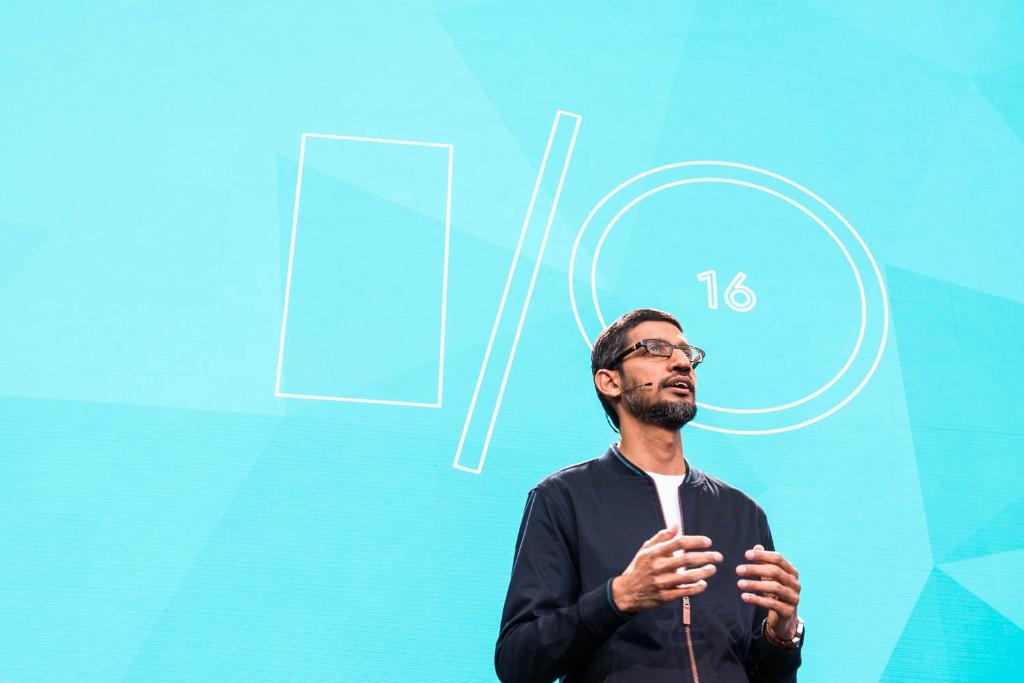

Google chief executive Sundar Pichai speaks at Google I/O 2016. Image credit: Google
On Day 1 of Google I/O 2016, Google brought to the stage on May 18 at Shoreline Amphitheater news involving its Android mobile operating system, unveiled a powerful analytics engine and introduced a new server ASIC (application-specific integrated circuit) at the same time.
Yes, Google not only creates software of all kinds, it also makes server components. In fact, it’s been building its own servers, networks and storage facilities for as long as it’s been in business, which is just shy of two decades.
Here’s a rundown of what Google announced for software developers on May 18.
Google I/O 2016: Google Allo And Duo Smart Messaging / Is Google Home Secure? / Android Wear 2.0 Adds Standalone Apps / Try our Android Quiz!
“In Android N, we want to achieve a new level of product excellence for Android, so we’ve carried out some pretty deep surgery to the platform, rewriting and redesigning some fundamental aspects of how the system works,” Google Android Vice-President of Engineering Dave Burke said.
“For Android N, we are focused on three key themes: performance, productivity and security. The first Developer Preview introduced a brand new JIT compiler to improve software performance, make app installs faster, and take up less storage. The second N Developer Preview included Vulkan, a new 3D rendering API to help game developers deliver high performance graphics on mobile devices.”
Both previews also brought useful productivity improvements to Android, including Multi-Window support and Direct Reply, Burke said.
Android N also adds some important new features to help keep users safer and more secure, Burke said.
“Inspired by how Chromebooks apply updates, we’re introducing seamless updates, so that new Android devices built on N can install system updates in the background,” Burke said. “This means that the next time a user powers up his device, new devices can automatically and seamlessly switch into the new updated system image.
“Today’s release of Android N Developer Preview 3 is our first beta-quality candidate, available to test on your primary phone or tablet,” Burke said.
Firebase Analytics reports helps users understand how users behave, which enables informed decisions regarding app marketing and performance optimizations.
“One of the most requested features by Firebase developers is the ability to store images, videos and other large files,” product manager James Tamplin wrote in his blog. “The new Firebase Storage is powered by Google Cloud Storage, giving it massive scalability and allowing stored files to be easily accessed by other projects running on Google Cloud Platform.
“Firebase now uses the same underlying account system as GCP, which means you can use any GCP product with your Firebase app. For example, you can export raw analytics data from the new Firebase Analytics to Google BigQuery to help you surface advanced insights about your application and users.”
Firebase will be a freely available component for all Android development in the future, Google said.
Continues on Page 2
Originally published on eWeek
Page: 1 2
OpenAI chief operating officer Brad Lightcap to oversee international expansion as company consolidates lead in…
Chinese researchers publish details on device that could wreak havoc on undersea communications cables in…
Former Intel chief Gelsinger expands role at Gloo, becoming executive chairman and head of technology…
MEPs add to Commission pressure for second EU Chips Act amidst industry calls for renewed…
Smartphone maker Xiaomi reportedly raises about $5.5bn in Hong Kong share sale as it invests…
BYD's Qin L EV sedan starts at about half the price of Tesla's Model 3,…